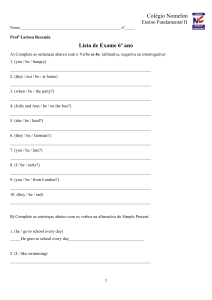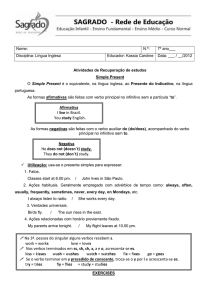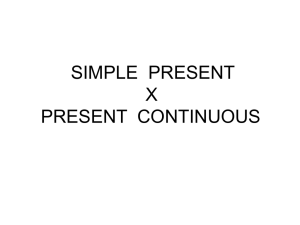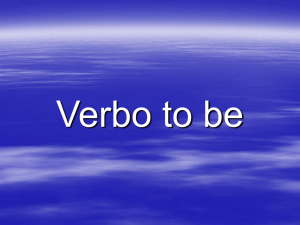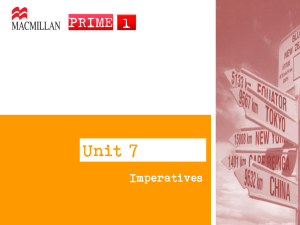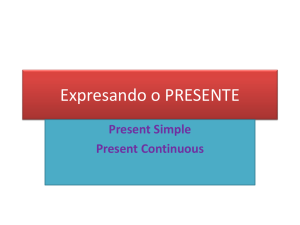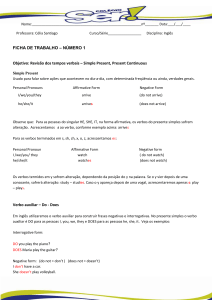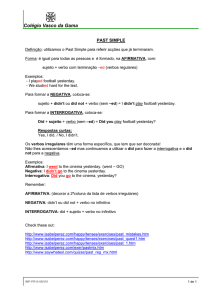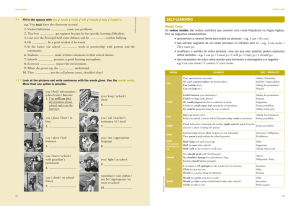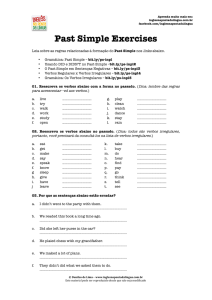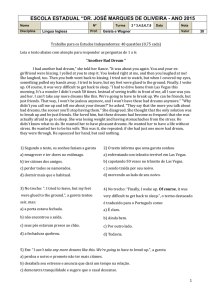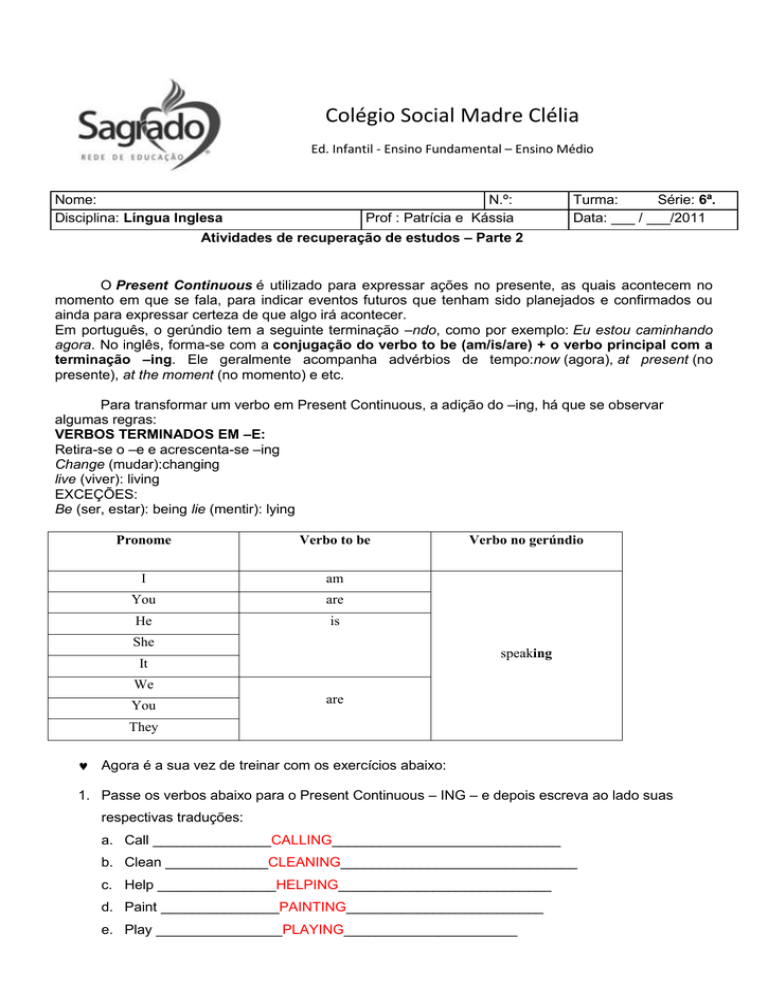
Colégio Social Madre Clélia
Ed. Infantil - Ensino Fundamental – Ensino Médio
Nome:
Disciplina: Língua Inglesa
N.º:
Prof : Patrícia e Kássia
Turma:
Série: 6ª.
Data: ___ / ___/2011
Atividades de recuperação de estudos – Parte 2
O Present Continuous é utilizado para expressar ações no presente, as quais acontecem no
momento em que se fala, para indicar eventos futuros que tenham sido planejados e confirmados ou
ainda para expressar certeza de que algo irá acontecer.
Em português, o gerúndio tem a seguinte terminação –ndo, como por exemplo: Eu estou caminhando
agora. No inglês, forma-se com a conjugação do verbo to be (am/is/are) + o verbo principal com a
terminação –ing. Ele geralmente acompanha advérbios de tempo:now (agora), at present (no
presente), at the moment (no momento) e etc.
Para transformar um verbo em Present Continuous, a adição do –ing, há que se observar
algumas regras:
VERBOS TERMINADOS EM –E:
Retira-se o –e e acrescenta-se –ing
Change (mudar):changing
live (viver): living
EXCEÇÕES:
Be (ser, estar): being lie (mentir): lying
Pronome
Verbo to be
I
am
You
are
He
is
She
Verbo no gerúndio
speaking
It
We
You
are
They
Agora é a sua vez de treinar com os exercícios abaixo:
1. Passe os verbos abaixo para o Present Continuous – ING – e depois escreva ao lado suas
respectivas traduções:
a. Call _______________CALLING_____________________________
b. Clean _____________CLEANING______________________________
c. Help _______________HELPING___________________________
d. Paint _______________PAINTING_________________________
e. Play ________________PLAYING______________________
f.
Read ____________
READING_____________________________
g. Watch ______________WATCHING___________________________
h. Sleep _______________SLEEPING___________________________
i.
Get _________________GETTING___________________________
j.
Have ________________HAVING____________________________
k. Leave _______________LEAVING___________________________
l.
Mop ________________MOPPING___________________________
m. Finish _______________FINISHING__________________________
n. Stop ________________STOPPING__________________________
o. Vacuum ____________VACUUMING_________________________
p. Wake ________________WAKING___________________________
q. Eat __________________EATING___________________________
r.
Run _________________RUNNING__________________________
s. Write ________________WRITING____________________________
2. Escreva sentenças com as palavras abaixo usando o Present Continuous. Não esqueça do
verbo to be.
a. Jerry / not vacuum / the dining room.
Jerry is not vacuuming the dining room.
b. Sue and Fred / mop / the kitchen floor.
Sue and Fred are mopping the kitchen floor.
c. I / not stay / at home.
I´m not staying at home.
d. We / leave / the house.
We are leaving the house.
e. Grandpa / not water / the plants.
Grandpa is not water the plants
f.
You / finish / the lesson.
You is finishing the lesson.
3. Forme perguntas com as palavras abaixo usando o Present Continuous. Não esqueça do verbo
to be.
a. Hanson / eat a slice of pizza.
Is Hanson eating a slice of pizza?
b. Collen and Dan / read a magazine
Are Collen and Dan reading a magazine?
c. Edna / mop the floor
Is Edna mopping th floor?
d. Josh / sleep
Is Josh slepping?
e. Anita and Jennifer / watch TV
Are Anita and Jennifer watching TV?
f.
Edson / talk on the phone
Is Edson talking on the phone?
4. Complete os espaços com os verbos abaixo. Use o Present Continuous e não esqueça do verbo
to be.
WATCH
DANCE
EAT
TALK
READ
PLAY
a. Edna is talking on the phone.
b. Hanson is eating a slice of pizza.
c. Collen and Dan are dancing.
d. Josh is palying the guitar.
e. Anita and Jennifer are watching TV.
f.
Eddie is reading a magazine.
→ Olhe e leia com atenção o quadro da gramática do Present Continuous na forma afirmativa:
sujeito
to be verbo principal forma contraída
am
walking.
I’m walking.
I
is
walking.
He’s / She’s / It’s walking.
He / she / it
walking.
We’re / you’re / they’re walking.
We / you / they are
→ Use o Present Continuous quando estiver falando de algo que está acontecendo neste
momento.
5. Escreva sentenças usando o Present Continuous
a. Sue and Fred / mop / the kitchen floor. _____Sue and Fred are mopping the kitchen floor.
b. I / not stay / at home._I not staying at home.
c. We / leave / the house. We are leaving the house.
d. Grandpa / not water / the plants. Grandpa isn´t water the plants
6. Escolha a alternativa correta para completar as sentenças:
a. We usually _________________ Italian food.
( eat / eats / am eating )
b. Angelina _____________ orange juice right now.
( drinks / is drinking / are drinking )
c. Dorothy and I _____________ horror movies.
( like / likes / are liking )
d. Doctor House always _______________ fish and vegetables for lunch.
( have / are having / has )
7. Complete as sentenças com o Simple Present ou Present Continuous dos verbos entre parênteses:
a. Vera and Carl never are playing (play) volleyball with his friends right now.
b. I can’t talk to them right now. We are cycle(cyle) to school.
c. Edi usually is watches (watch) reality shows on Friday nights.
d. Lara doesn´t use(not use) the computer right now.
e. I can’t come to your house now. I ´m help (help) my mother.
7. Choose the correct alternative to complete the sentences. (Escolha a alternativa correta para completar as
sentenças. Atenção ao tempo verbal: Simple Present ou Present Continuous)
a. We usually _________________ Italian food.
( eat / eats / am eating )
b. Angelina _____________ orange juice right now.
( drinks / is drinking / are drinking )
c. Dorothy and I _____________ horror movies.
( like / likes / are liking )
d. Doctor House always _______________ fish and vegetables for lunch.
( have / are having / has )
e. I can’t talk to you now. I ________________ my homework.
( do / am doing / is doing )
f.
They _________________ in the club right now.
( are playing ball / play ball / is playing ball )
g. Mark is a mechanic. He _______________ cars everyday.
( is fixing / fix / fixes )
8. Fill in the blanks with Present Continuous. (Complete os espaços com o Present Continuous)
a. My brother is___fishing_______________(fish) today. Fishing is his favorite sport.
b. Tina’s car isn’t working today, so she is_______cycling_______________(cycle) to work.
c.
Sam and Julie are_______swimming_____________(swim) in the lake.
d. Look at that brave man! He is__________diving__________(dive) into the cold water!
e. The sun is shining, and I am_____________sunbathing___________ (sunbathe) in the yard.
9. Order of adjectives – size and color
size
color
Cindy has a big blue schoolbag.
→ Coloque os adjetivos entre parênteses na ordem correta:
a) My cousin has __________short brown____ hair. (brown / short)
b) We have a ____________little black_______dog. (little / black)
c) Your __________________tiny red______ calculator is great! (red / tiny)
d) They have a _________big white__________ refrigerator in the kitchen. (big/white)
e) The ___________________tall green ___trees are beautiful. ( green / tall)
f) Whose ______tiny yellow cups__________ are these? (cups / yellow / tiny )
g) Whose ______small gray car___________ is that? ( small / car / gray )
h) Whose ______short black socks_________ are these? (socks / short / black )
i) Whose _______small pink bag____________ is there? (bag / pink / small)
l) Whose _______little green blouse__________ is there? ( blouse / green / little)
noun
10. Relacione as perguntas com suas respectivas respostas:
(1) Why are you watching TV?
( 2 ) Because the game is starting.
(2) Why are you they running?
( 1 ) Because there´s a basketball game tonight.
(3) Why is that boy mopping the floor?
( 4 ) Because her team is winning.
(4) Why is that girl happy?
( 5 ) Because I´m tired.
(5) Why are you going to bed?
( 3 ) Because there´s water on it.
11. Complete os espaços com as palavras corretas abaixo:
Respostas do exercício 11:
2- cloud /3- Wind / 4- lightning / 5- thunder / 6- snow
→ Faça uma lista com o vocabulário das unidades 9 , 14 e 15 e estude com muita atenção!
→ Sunny= ensolarado
→ Windy= ventoso
→ Cloudy= nublado
→ Rainy= chuvoso
→ Snowy= neve
→ Hot= quente
→ Cold= frio
→ Leaves= folhas
→ Small= pequeno
→ Large= grande
→ Red= vermelho
→ Opposite adjectives:
→ Strong / weak= Forte / fraco
→ Hardworking / lazy = Estudioso / preguiçoso
→ Outgoing/ shy = Extrovertido / tímido
→ Cheerful / unhappy = Alegre / tris
→ Funny:engraçado
Athletic: Atlético
→ Loud:Alto
→ Kind:Amável

